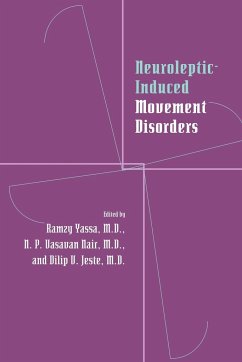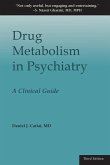Ramzy Yassa / N. P. V. Nair / Dilip V. Jeste (eds.)A Comprehensive Survey
Neuroleptic-Induced Movement Disorders
A Comprehensive Survey
Herausgeber: Yassa, Ramzy; Jeste, Dilip V.; Nair, N. P. V.
Ramzy Yassa / N. P. V. Nair / Dilip V. Jeste (eds.)A Comprehensive Survey
Neuroleptic-Induced Movement Disorders
A Comprehensive Survey
Herausgeber: Yassa, Ramzy; Jeste, Dilip V.; Nair, N. P. V.
- Broschiertes Buch
- Merkliste
- Auf die Merkliste
- Bewerten Bewerten
- Teilen
- Produkt teilen
- Produkterinnerung
- Produkterinnerung
Neuroleptics, the most widely prescribed group of psychotropic drugs, are indispensable in the management of a majority of patients with schizophrenia, as well as other psychoses, yet they have not proved to be an unmixed blessing. They are associated with troublesome adverse effects, of which movement disorders are the most serious in terms of frequency, persistence and overall impact on the well-being of patients and care-givers. This book was prepared with the aim of improving understanding and clinical management of these iatrogenic conditions. It deals with historical, clinical and…mehr
Andere Kunden interessierten sich auch für
![Finding Kali Finding Kali]() Kali Rae WheelerFinding Kali17,99 €
Kali Rae WheelerFinding Kali17,99 €![Drug Metabolism in Psychiatry Drug Metabolism in Psychiatry]() Daniel J CarlatDrug Metabolism in Psychiatry36,99 €
Daniel J CarlatDrug Metabolism in Psychiatry36,99 €![Losing Kali Losing Kali]() Kali Rae WheelerLosing Kali16,99 €
Kali Rae WheelerLosing Kali16,99 €![Missing Kali Missing Kali]() Kali Rae WheelerMissing Kali19,99 €
Kali Rae WheelerMissing Kali19,99 €![Psychiatry Practice Boosters, Third Edition Psychiatry Practice Boosters, Third Edition]() Psychiatry Practice Boosters, Third Edition50,99 €
Psychiatry Practice Boosters, Third Edition50,99 €![Psychopharmacology in Cancer Care Psychopharmacology in Cancer Care]() Andrew RothPsychopharmacology in Cancer Care50,99 €
Andrew RothPsychopharmacology in Cancer Care50,99 €![Psychopharmacology Psychopharmacology]() David LongoPsychopharmacology17,99 €
David LongoPsychopharmacology17,99 €-
-
-
Neuroleptics, the most widely prescribed group of psychotropic drugs, are indispensable in the management of a majority of patients with schizophrenia, as well as other psychoses, yet they have not proved to be an unmixed blessing. They are associated with troublesome adverse effects, of which movement disorders are the most serious in terms of frequency, persistence and overall impact on the well-being of patients and care-givers. This book was prepared with the aim of improving understanding and clinical management of these iatrogenic conditions. It deals with historical, clinical and neurobiological aspects of tardive dyskinesia and related movement disorders such as parkinsonism, dystonia and akathisia. Sections are also devoted to the measurement of tardive dyskinesia, to geographical and ethnic differences, and to management with novel neuroleptic agents and biofeedback. With authoritative contributions and an international perspective, this book will be valuable to clinicians and researchers alike in psychiatry, neurology and related disciplines.
Produktdetails
- Produktdetails
- Verlag: Cambridge University Press
- Seitenzahl: 516
- Erscheinungstermin: 29. Dezember 2006
- Englisch
- Abmessung: 229mm x 152mm x 30mm
- Gewicht: 829g
- ISBN-13: 9780521033527
- ISBN-10: 0521033527
- Artikelnr.: 22580016
- Herstellerkennzeichnung
- Libri GmbH
- Europaallee 1
- 36244 Bad Hersfeld
- gpsr@libri.de
- Verlag: Cambridge University Press
- Seitenzahl: 516
- Erscheinungstermin: 29. Dezember 2006
- Englisch
- Abmessung: 229mm x 152mm x 30mm
- Gewicht: 829g
- ISBN-13: 9780521033527
- ISBN-10: 0521033527
- Artikelnr.: 22580016
- Herstellerkennzeichnung
- Libri GmbH
- Europaallee 1
- 36244 Bad Hersfeld
- gpsr@libri.de
Contributors; Preface; Part I. Historical Perspective: 1.
Neuroleptic-induced movement disorders: historical perspective Marc-Alain
Wolf, Ramzy Yassa and Pierre-Michel Llorca; Part II. Clinical Aspects of
Tardive Dyskinesia: 2. Aging and tardive dyskinesia Bruce L. Saltz, John M.
Kane, Margaret G. Woerner, Jeffrey A. Lieberman and José Ma. J. Alvir; 3.
Gender as a factor in the development of tardive dyskinesia Ramzy Yassa and
Dilip V. Jeste; 4. The Yale tardive dyskinesia study: a prospective
incidence study among long-term outpatients William M. Glazer, Hal
Morgenstern, Donna Raye Wagner and John Doucette; 5. Vulnerability to
tardive dyskinesia in schizophrenia: an exploration of individual patient
factors John L. Waddington, Eadbhard O'Callaghan, Peter Buckely, Cathy
Madigan, Conall Larkin and Anthony Kinsella; 6. Tardive dyskinesia and
affective disorder George Gardos and Jonathan O. Cole; 7. Diabetes mellitus
and tardive dyskinesia Sukdeb Mukherjee and Sahebarao P. Mahadik; 8. Other
factors in the development of tardive dyskinesia Ramzy Yassa; 9.
Neuroleptic treatment and tardive dyskinesia George Gardos and Jonathan O.
Cole; 10. Anticholinergic drugs as factors in the development of tardive
dyskinesia Ramzy Yassa and N. P. V. Nair; Part III. Mechanisms Underlying
Tardive Dyskinesia: 11. Neurochemistry of the basal ganglia N. P. V. Nair
and T. E. G. West; 12. A reanalysis of the dopamine theory of tardive
dyskinesia: the hypothesis of dopamine D1/D2 imbalance Linda Peacock and
Jes Gerlach; 13. Tardive dyskinesia and phenylalanine metabolism:
risk-factor studies Mary Ann Richardson, Cheryl Flynn, Laura Read, Margaret
Reilly and Raymond Suckow; 14. Neuroendocrinological studies of tardive
dyskinesia Margot Albus; 15. Cognitive deficits and tardive dyskinesia
Marion E. Wolf, Alan S. DeWolfe and Aron D. Mosnaim; 16. Studies of tardive
dyskinesia using computed tomography and magnetic-resonance imaging
Christian L. Shriqui; 17. Rodent and other animal models of tardive
dyskinesia during long-term neuroleptic-drug administration: controversies
and implications for the clinical syndrome John L. Waddington; Part IV.
Measurement of Tardive Dyskinesia: 18. Instrument measurements of tardive
dyskinesia Michael P. Caligiuri; Part V. Tardive Dyskinesia in Different
Populations: 19. Cultural aspects of tardive dyskinesia in Asia Shigeto
Yamawaki, Teruo Hayashi; Ikuo Nagaoka, Hiroshi Saitoh, Norio Yokota and
Yosuke Uchitomi; 20. Tardive dyskinesia in North America and the Middle
East Driss Moussaoui; 21. Tardive dyskinesia in Europe H. A. McClelland and
T. A. Kerr; 22. Role of ethnicity in the development of tardive dyskinesia
Jonathan P. Lacro and Dilip V. Jeste; 23. Tardive dyskinesia in children
and adolescents Mark Magulac and Dilip V. Jeste; Part VI. Other
Neuropleptic-Induced Movement Disorders: 24. Drug-induced parkinsonism
Thomas E. Hansen and William F. Hoffman; 25. Clinical aspects of
neuroleptic-induced dystonia George A. Keepers and Linda Ganzini; 26.
Tardive dystonia Paul Greene; 27. Tardive akathisia Robert E. Burke; Part
VII. Treatment of Tardive Dyskinesia: 28. Development of novel
antipsychotic drugs with reduced extrapyramidal side effects Allan Z.
Safferman, Jeffrey A. Lieberman, Bruce J. Kinon, Daniel Umbricht, Jeffrey
S. Aronowitz and John M. Kane; 29. GABAergic treatments for tardive
dyskinesia Shawn L. Cassady, Gunvant K. Thaker and Carol A. Tamminga; 30.
Using biofeedback to train suppression of the oral-lingual movements of
tardive dyskinesia Ronald C. Fudge and Cecile E. Sison; Index.
Neuroleptic-induced movement disorders: historical perspective Marc-Alain
Wolf, Ramzy Yassa and Pierre-Michel Llorca; Part II. Clinical Aspects of
Tardive Dyskinesia: 2. Aging and tardive dyskinesia Bruce L. Saltz, John M.
Kane, Margaret G. Woerner, Jeffrey A. Lieberman and José Ma. J. Alvir; 3.
Gender as a factor in the development of tardive dyskinesia Ramzy Yassa and
Dilip V. Jeste; 4. The Yale tardive dyskinesia study: a prospective
incidence study among long-term outpatients William M. Glazer, Hal
Morgenstern, Donna Raye Wagner and John Doucette; 5. Vulnerability to
tardive dyskinesia in schizophrenia: an exploration of individual patient
factors John L. Waddington, Eadbhard O'Callaghan, Peter Buckely, Cathy
Madigan, Conall Larkin and Anthony Kinsella; 6. Tardive dyskinesia and
affective disorder George Gardos and Jonathan O. Cole; 7. Diabetes mellitus
and tardive dyskinesia Sukdeb Mukherjee and Sahebarao P. Mahadik; 8. Other
factors in the development of tardive dyskinesia Ramzy Yassa; 9.
Neuroleptic treatment and tardive dyskinesia George Gardos and Jonathan O.
Cole; 10. Anticholinergic drugs as factors in the development of tardive
dyskinesia Ramzy Yassa and N. P. V. Nair; Part III. Mechanisms Underlying
Tardive Dyskinesia: 11. Neurochemistry of the basal ganglia N. P. V. Nair
and T. E. G. West; 12. A reanalysis of the dopamine theory of tardive
dyskinesia: the hypothesis of dopamine D1/D2 imbalance Linda Peacock and
Jes Gerlach; 13. Tardive dyskinesia and phenylalanine metabolism:
risk-factor studies Mary Ann Richardson, Cheryl Flynn, Laura Read, Margaret
Reilly and Raymond Suckow; 14. Neuroendocrinological studies of tardive
dyskinesia Margot Albus; 15. Cognitive deficits and tardive dyskinesia
Marion E. Wolf, Alan S. DeWolfe and Aron D. Mosnaim; 16. Studies of tardive
dyskinesia using computed tomography and magnetic-resonance imaging
Christian L. Shriqui; 17. Rodent and other animal models of tardive
dyskinesia during long-term neuroleptic-drug administration: controversies
and implications for the clinical syndrome John L. Waddington; Part IV.
Measurement of Tardive Dyskinesia: 18. Instrument measurements of tardive
dyskinesia Michael P. Caligiuri; Part V. Tardive Dyskinesia in Different
Populations: 19. Cultural aspects of tardive dyskinesia in Asia Shigeto
Yamawaki, Teruo Hayashi; Ikuo Nagaoka, Hiroshi Saitoh, Norio Yokota and
Yosuke Uchitomi; 20. Tardive dyskinesia in North America and the Middle
East Driss Moussaoui; 21. Tardive dyskinesia in Europe H. A. McClelland and
T. A. Kerr; 22. Role of ethnicity in the development of tardive dyskinesia
Jonathan P. Lacro and Dilip V. Jeste; 23. Tardive dyskinesia in children
and adolescents Mark Magulac and Dilip V. Jeste; Part VI. Other
Neuropleptic-Induced Movement Disorders: 24. Drug-induced parkinsonism
Thomas E. Hansen and William F. Hoffman; 25. Clinical aspects of
neuroleptic-induced dystonia George A. Keepers and Linda Ganzini; 26.
Tardive dystonia Paul Greene; 27. Tardive akathisia Robert E. Burke; Part
VII. Treatment of Tardive Dyskinesia: 28. Development of novel
antipsychotic drugs with reduced extrapyramidal side effects Allan Z.
Safferman, Jeffrey A. Lieberman, Bruce J. Kinon, Daniel Umbricht, Jeffrey
S. Aronowitz and John M. Kane; 29. GABAergic treatments for tardive
dyskinesia Shawn L. Cassady, Gunvant K. Thaker and Carol A. Tamminga; 30.
Using biofeedback to train suppression of the oral-lingual movements of
tardive dyskinesia Ronald C. Fudge and Cecile E. Sison; Index.
Contributors; Preface; Part I. Historical Perspective: 1.
Neuroleptic-induced movement disorders: historical perspective Marc-Alain
Wolf, Ramzy Yassa and Pierre-Michel Llorca; Part II. Clinical Aspects of
Tardive Dyskinesia: 2. Aging and tardive dyskinesia Bruce L. Saltz, John M.
Kane, Margaret G. Woerner, Jeffrey A. Lieberman and José Ma. J. Alvir; 3.
Gender as a factor in the development of tardive dyskinesia Ramzy Yassa and
Dilip V. Jeste; 4. The Yale tardive dyskinesia study: a prospective
incidence study among long-term outpatients William M. Glazer, Hal
Morgenstern, Donna Raye Wagner and John Doucette; 5. Vulnerability to
tardive dyskinesia in schizophrenia: an exploration of individual patient
factors John L. Waddington, Eadbhard O'Callaghan, Peter Buckely, Cathy
Madigan, Conall Larkin and Anthony Kinsella; 6. Tardive dyskinesia and
affective disorder George Gardos and Jonathan O. Cole; 7. Diabetes mellitus
and tardive dyskinesia Sukdeb Mukherjee and Sahebarao P. Mahadik; 8. Other
factors in the development of tardive dyskinesia Ramzy Yassa; 9.
Neuroleptic treatment and tardive dyskinesia George Gardos and Jonathan O.
Cole; 10. Anticholinergic drugs as factors in the development of tardive
dyskinesia Ramzy Yassa and N. P. V. Nair; Part III. Mechanisms Underlying
Tardive Dyskinesia: 11. Neurochemistry of the basal ganglia N. P. V. Nair
and T. E. G. West; 12. A reanalysis of the dopamine theory of tardive
dyskinesia: the hypothesis of dopamine D1/D2 imbalance Linda Peacock and
Jes Gerlach; 13. Tardive dyskinesia and phenylalanine metabolism:
risk-factor studies Mary Ann Richardson, Cheryl Flynn, Laura Read, Margaret
Reilly and Raymond Suckow; 14. Neuroendocrinological studies of tardive
dyskinesia Margot Albus; 15. Cognitive deficits and tardive dyskinesia
Marion E. Wolf, Alan S. DeWolfe and Aron D. Mosnaim; 16. Studies of tardive
dyskinesia using computed tomography and magnetic-resonance imaging
Christian L. Shriqui; 17. Rodent and other animal models of tardive
dyskinesia during long-term neuroleptic-drug administration: controversies
and implications for the clinical syndrome John L. Waddington; Part IV.
Measurement of Tardive Dyskinesia: 18. Instrument measurements of tardive
dyskinesia Michael P. Caligiuri; Part V. Tardive Dyskinesia in Different
Populations: 19. Cultural aspects of tardive dyskinesia in Asia Shigeto
Yamawaki, Teruo Hayashi; Ikuo Nagaoka, Hiroshi Saitoh, Norio Yokota and
Yosuke Uchitomi; 20. Tardive dyskinesia in North America and the Middle
East Driss Moussaoui; 21. Tardive dyskinesia in Europe H. A. McClelland and
T. A. Kerr; 22. Role of ethnicity in the development of tardive dyskinesia
Jonathan P. Lacro and Dilip V. Jeste; 23. Tardive dyskinesia in children
and adolescents Mark Magulac and Dilip V. Jeste; Part VI. Other
Neuropleptic-Induced Movement Disorders: 24. Drug-induced parkinsonism
Thomas E. Hansen and William F. Hoffman; 25. Clinical aspects of
neuroleptic-induced dystonia George A. Keepers and Linda Ganzini; 26.
Tardive dystonia Paul Greene; 27. Tardive akathisia Robert E. Burke; Part
VII. Treatment of Tardive Dyskinesia: 28. Development of novel
antipsychotic drugs with reduced extrapyramidal side effects Allan Z.
Safferman, Jeffrey A. Lieberman, Bruce J. Kinon, Daniel Umbricht, Jeffrey
S. Aronowitz and John M. Kane; 29. GABAergic treatments for tardive
dyskinesia Shawn L. Cassady, Gunvant K. Thaker and Carol A. Tamminga; 30.
Using biofeedback to train suppression of the oral-lingual movements of
tardive dyskinesia Ronald C. Fudge and Cecile E. Sison; Index.
Neuroleptic-induced movement disorders: historical perspective Marc-Alain
Wolf, Ramzy Yassa and Pierre-Michel Llorca; Part II. Clinical Aspects of
Tardive Dyskinesia: 2. Aging and tardive dyskinesia Bruce L. Saltz, John M.
Kane, Margaret G. Woerner, Jeffrey A. Lieberman and José Ma. J. Alvir; 3.
Gender as a factor in the development of tardive dyskinesia Ramzy Yassa and
Dilip V. Jeste; 4. The Yale tardive dyskinesia study: a prospective
incidence study among long-term outpatients William M. Glazer, Hal
Morgenstern, Donna Raye Wagner and John Doucette; 5. Vulnerability to
tardive dyskinesia in schizophrenia: an exploration of individual patient
factors John L. Waddington, Eadbhard O'Callaghan, Peter Buckely, Cathy
Madigan, Conall Larkin and Anthony Kinsella; 6. Tardive dyskinesia and
affective disorder George Gardos and Jonathan O. Cole; 7. Diabetes mellitus
and tardive dyskinesia Sukdeb Mukherjee and Sahebarao P. Mahadik; 8. Other
factors in the development of tardive dyskinesia Ramzy Yassa; 9.
Neuroleptic treatment and tardive dyskinesia George Gardos and Jonathan O.
Cole; 10. Anticholinergic drugs as factors in the development of tardive
dyskinesia Ramzy Yassa and N. P. V. Nair; Part III. Mechanisms Underlying
Tardive Dyskinesia: 11. Neurochemistry of the basal ganglia N. P. V. Nair
and T. E. G. West; 12. A reanalysis of the dopamine theory of tardive
dyskinesia: the hypothesis of dopamine D1/D2 imbalance Linda Peacock and
Jes Gerlach; 13. Tardive dyskinesia and phenylalanine metabolism:
risk-factor studies Mary Ann Richardson, Cheryl Flynn, Laura Read, Margaret
Reilly and Raymond Suckow; 14. Neuroendocrinological studies of tardive
dyskinesia Margot Albus; 15. Cognitive deficits and tardive dyskinesia
Marion E. Wolf, Alan S. DeWolfe and Aron D. Mosnaim; 16. Studies of tardive
dyskinesia using computed tomography and magnetic-resonance imaging
Christian L. Shriqui; 17. Rodent and other animal models of tardive
dyskinesia during long-term neuroleptic-drug administration: controversies
and implications for the clinical syndrome John L. Waddington; Part IV.
Measurement of Tardive Dyskinesia: 18. Instrument measurements of tardive
dyskinesia Michael P. Caligiuri; Part V. Tardive Dyskinesia in Different
Populations: 19. Cultural aspects of tardive dyskinesia in Asia Shigeto
Yamawaki, Teruo Hayashi; Ikuo Nagaoka, Hiroshi Saitoh, Norio Yokota and
Yosuke Uchitomi; 20. Tardive dyskinesia in North America and the Middle
East Driss Moussaoui; 21. Tardive dyskinesia in Europe H. A. McClelland and
T. A. Kerr; 22. Role of ethnicity in the development of tardive dyskinesia
Jonathan P. Lacro and Dilip V. Jeste; 23. Tardive dyskinesia in children
and adolescents Mark Magulac and Dilip V. Jeste; Part VI. Other
Neuropleptic-Induced Movement Disorders: 24. Drug-induced parkinsonism
Thomas E. Hansen and William F. Hoffman; 25. Clinical aspects of
neuroleptic-induced dystonia George A. Keepers and Linda Ganzini; 26.
Tardive dystonia Paul Greene; 27. Tardive akathisia Robert E. Burke; Part
VII. Treatment of Tardive Dyskinesia: 28. Development of novel
antipsychotic drugs with reduced extrapyramidal side effects Allan Z.
Safferman, Jeffrey A. Lieberman, Bruce J. Kinon, Daniel Umbricht, Jeffrey
S. Aronowitz and John M. Kane; 29. GABAergic treatments for tardive
dyskinesia Shawn L. Cassady, Gunvant K. Thaker and Carol A. Tamminga; 30.
Using biofeedback to train suppression of the oral-lingual movements of
tardive dyskinesia Ronald C. Fudge and Cecile E. Sison; Index.









